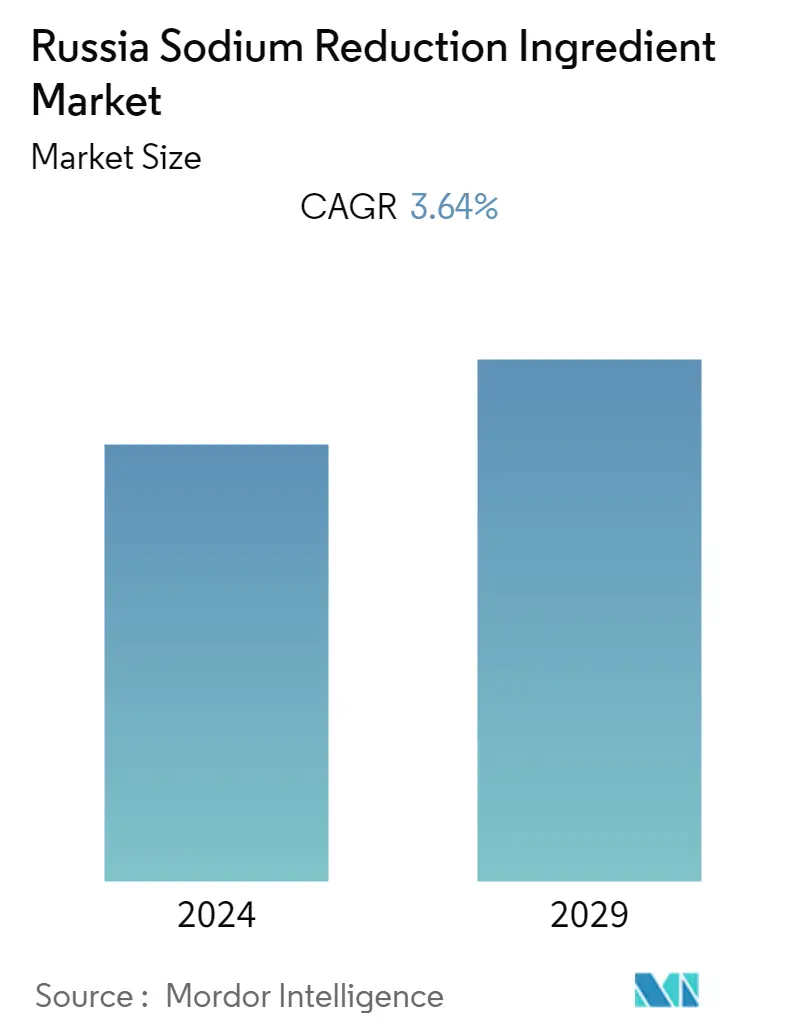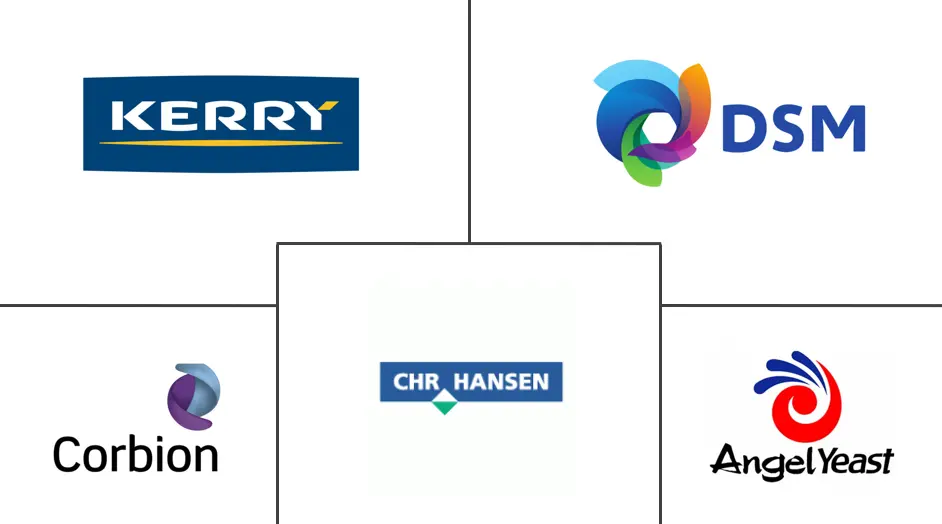Market Size of Russia Sodium Reduction Ingredient Industry

| Study Period | 2019 - 2029 |
| Base Year For Estimation | 2023 |
| Forecast Data Period | 2024 - 2029 |
| Historical Data Period | 2019 - 2022 |
| CAGR | 3.64 % |
| Market Concentration | Low |
Major Players
*Disclaimer: Major Players sorted in no particular order |
Russia Sodium Reduction Ingredient Market Analysis
Russia's sodium reduction ingredients market is projected to grow at a CAGR of 3.64% during the forecast period (2020 - 2025).
- Some of the major factors driving demand for sodium reduction ingredients in Russia include the greater emphasis on health nutrition, the growing knowledge with regard to the detrimental effects of excessive intake of salt, improvement in taste and increased demand for processed foods.
- Excessive intake of sodium leads to a number of adverse health effects, hypertension being foremost among them. Alleviating these conditions to some extent has been possible through the use of sodium reduction ingredients, such as mineral salts, amino acids, and yeast extracts. Versatility in its application has provided the requisite impetus to these health-promoting products.
- In order to keep its population healthy and fit, the Russian Federation has been continuously mapping salt reduction initiatives as a healthy nutrition plan which is likely to drive the market for salt reduction ingredients in Russia during the forecast period.
Russia Sodium Reduction Ingredient Industry Segmentation
The Russian sodium reduction ingredients market is segmented by product type and application. Based on product type, the market is segmented into amino acids & glutamates, mineral salts, yeast extracts, and others. Based on application, the market is segmented into bakery & confectionery, condiments, seasonings & sauces, dairy & frozen foods, meat & meat products, snacks, and others.
| By Type | |
| Amino Acids & Glutamates | |
| Mineral Salts | |
| Yeast Extracts | |
| Others |
| By Application | |
| Bakery & Confectionery | |
| Condiments, Seasonings & Sauces | |
| Dairy & Frozen Foods | |
| Meat, Poultry & Seafood Products | |
| Snacks | |
| Others |
Russia Sodium Reduction Ingredient Market Size Summary
The sodium reduction ingredient market in Russia is experiencing growth driven by an increasing focus on health and nutrition, alongside a rising awareness of the negative health impacts associated with high salt consumption. This market is supported by the Russian government's initiatives to promote healthy eating habits, which include salt reduction strategies. The demand for sodium reduction ingredients such as mineral salts, amino acids, and yeast extracts is bolstered by their versatility and effectiveness in improving food taste while reducing sodium content. Yeast extracts, in particular, are gaining traction for their ability to enhance the flavor of savory foods, making them a popular choice among consumers and manufacturers aiming to lower sodium levels without compromising taste.
The market landscape is characterized by the presence of several key players, including global companies like Jungbunzlauer Holding AG, Corbion N.V., and Kerry Group plc, who are actively innovating to maintain a competitive edge. These companies are developing advanced solutions such as yeast extracts that offer umami flavoring, which helps in reducing salt while enhancing flavor perception. Additionally, the market is seeing advancements in alternative sodium reduction methods, such as the use of potassium chloride and the manipulation of sodium chloride's shape, particularly in the snacks segment. The condiments, seasoning, and sauces sectors also present significant opportunities for market players to introduce low-sodium products, with companies like Corbion Purac offering specialized solutions to meet the growing demand for sodium reduction in various food applications.
Russia Sodium Reduction Ingredient Market Size - Table of Contents
-
1. MARKET DYNAMICS
-
1.1 Market Drivers
-
1.2 Market Restraints
-
1.3 Porter's Five Forces Analysis
-
1.3.1 Threat of New Entrants
-
1.3.2 Bargaining Power of Buyers/Consumers
-
1.3.3 Bargaining Power of Suppliers
-
1.3.4 Threat of Substitute Products
-
1.3.5 Intensity of Competitive Rivalry
-
-
-
2. MARKET SEGMENTATION
-
2.1 By Type
-
2.1.1 Amino Acids & Glutamates
-
2.1.2 Mineral Salts
-
2.1.3 Yeast Extracts
-
2.1.4 Others
-
-
2.2 By Application
-
2.2.1 Bakery & Confectionery
-
2.2.2 Condiments, Seasonings & Sauces
-
2.2.3 Dairy & Frozen Foods
-
2.2.4 Meat, Poultry & Seafood Products
-
2.2.5 Snacks
-
2.2.6 Others
-
-
Russia Sodium Reduction Ingredient Market Size FAQs
What is the current Russia Sodium Reduction Ingredient Market size?
The Russia Sodium Reduction Ingredient Market is projected to register a CAGR of 3.64% during the forecast period (2024-2029)
Who are the key players in Russia Sodium Reduction Ingredient Market?
Jungbunzlauer Holding AG, Corbion N.V., Kerry Group plc, Angel Yeast Co. Ltd., Armor Proteines SAS and Koninklijke DSM N.V. are the major companies operating in the Russia Sodium Reduction Ingredient Market.

